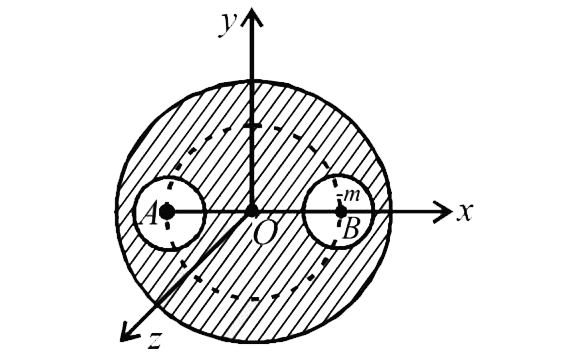A nonconducting sphere of radius R=5cm has its center at the origin O of the coordinate system as shown in (Fig. 3.112). It has two spherical cavities of radius r=1cm, whose centers are at 0,3cm and 0,−3cm, respectively, and solid material of the sphere has uniform positive charge density ρ=1/πμCm−3. Calculate the electric potential at point P(4cm,0).
 .
.
The correct Answer is:4345πε0×10−10 Volt
Charge on the sphere (including cavities)
Q=43πR3ρ=43π(5×10−2)31π×10−6=5003×10−12C
Charge in a volume equal to that of cavity
q=43πR3ρ=43π(1×10−2)31π×10−6=43×10−12C
Potential at P
Vp=Vwhole sphere−2Vcavity
=kQ2R[3−x2R2]−2kq5×10−2
=9×109×(500/3)×10−122×5×10−2[3−(45)2]
−2×9×109×(4/3)×10−125×10−2
=87325=34.92V.
Topper's Solved these Questions
- ELECTRIC POTENTIALBOOK - CENGAGE PHYSICSCHAPTER - ELECTRIC POTENTIALEXERCISE - Single Correct
56 Videos
- ELECTRIC POTENTIALBOOK - CENGAGE PHYSICSCHAPTER - ELECTRIC POTENTIALEXERCISE - Multiple Correct
10 Videos
- ELECTRIC POTENTIALBOOK - CENGAGE PHYSICSCHAPTER - ELECTRIC POTENTIALEXERCISE - Exercise 3.3
9 Videos
- ELECTRIC FLUX AND GAUSS LAWBOOK - CENGAGE PHYSICSCHAPTER - ELECTRIC FLUX AND GAUSS LAWEXERCISE - MCQ s
38 Videos
- ELECTRICAL MEASURING INSTRUMENTSBOOK - CENGAGE PHYSICSCHAPTER - ELECTRICAL MEASURING INSTRUMENTSEXERCISE - M.C.Q
2 Videos
Similar Questions
A non-conducting sphere of radius R=5cm has its center at origin O of co-ordinate system,shown in figure.It has a spherical cavity of radius r=1cm , whose centre is at (0,3cm) .Solid material of sphere has uniform positive charge density ρ=10−6πcolu−m−3 .Assume dielectric.Constant of material to be 1. The potential at point p(4cm,0) is approximately.
View SolutionA sphere of radius 2R has a uniform charge density p. The difference in the electric potential at r = R and r = 0 from the centre is:
View Solution
Knowledge Check
A solid sphere of uniform density and radius 4 units is located with its centre at the origin O of coordinates. Two sphere of equal radii 1 unit, with their centres at A(-2,0 ,0) and B(2,0,0) respectively, are taken out of the solid leaving behind spherical cavities as shown if fig Then:
 AThe gravitational force due to this object at the origin is zero.Bthe gravitational force at the point B(2,0,0) is zero.Cthe gravitational potential is the same at all points of circle y2+z2=36Dthe gravitational potential is the same at all points on the circle y2+z2=4.
AThe gravitational force due to this object at the origin is zero.Bthe gravitational force at the point B(2,0,0) is zero.Cthe gravitational potential is the same at all points of circle y2+z2=36Dthe gravitational potential is the same at all points on the circle y2+z2=4.A sphere of radius 1 cm has potential of 10000V, then energy density near its surface will be
A64×105J/m3B8×103J/m3C32J/m3D4.425J/m3A sphere of radius 1cm has potential of 8000V, then energy density near its surface will be
A64×105J/m3B8×103J/m3C32J/m3D2.83J/m3
A non-conducting sphere of radius R has a spherical cavity of radius R/2 as shown. The solid part of the sphere has a uniform volume charge density ρ. Find the magnitude and direction of electric field at point (a) O and (b) A.

View SolutionBy melting three spherical solid balls of radius 1 cm, 2 cm and 3 cm, respectively, a large spherical ball is formed. If 25% material is lost in this process, what will be the radius of the new ball?
View SolutionA sphere of radius 6 cm is melted and made three small spheres of radius 3 cm, 4 cm and r cm respectively, the value of r is ....................
View SolutionAn insulated charged conducting sphere of radius 5cm has a potential of 10V at the surface. What is the potential at centre?
View SolutionA spherical conductor of radius 2 cm is uniformly charged with 3 nC. What is the electric field at a distance of 3 cm from the centre of the sphere?
View Solution
